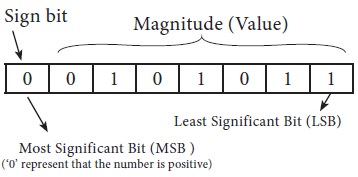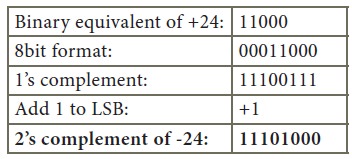Chapter: 11th Computer Science : Chapter 2 : Number Systems
Binary Representation for Signed Numbers
Binary Representation for Signed Numbers
Computers can handle both positive
(unsigned) and negative (signed) numbers. The simplest method to represent
negative binary numbers is called Signed
Magnitude. In signed magnitude method, the left most bit is Most
Significant Bit (MSB), is called sign
bit or parity bit.
The numbers are represented in
computers in different ways:
· Signed Magnitude representation
· 1’s Complement
· 2’s Complement
1. Signed Magnitude representation
The value of the whole numbers can
be determined by the sign used before it. If the number has ‘+’ sign or no sign
it will be considered as positive. If the number has ‘–’ sign it will be
considered as negative.
Example:
+43 or 43 is a positive number
–43 is a negative number
In signed binary representation,
the left most bit is considered as sign bit.
If this bit is 0, it is a positive
number and if it 1, it is a negative number. Therefore a signed binary number
has 8 bits, only 7 bits used for storing values (magnitude) and the 1 bit is
used for sign.
+43 is represented in memory as
follows:

-43 can be represented in memory
as follows.

2. 1’s Complement representation
This is an easier approach to
represent signed numbers. This is for negative numbers only i.e. the number
whose MSB is 1.
The steps to be followed to find
1’s complement of a number:
Step 1: Convert given Decimal
number into Binary
Step 2: Check if the binary number contains 8 bits , if less add 0 at the
left most bit, to make it as 8 bits.
Step 3: Invert all bits (i.e.
Change 1 as 0 and 0 as 1)
Example
Find 1’s complement for (–24)10

3. 2’s Complement representation
The 2’s-complement method for
negative number is as follows:
1.
Invert
all the bits in the binary sequence (i.e., change every 0 to1 and every 1 to 0
ie.,1’s complement)
2.
Add 1
to the result to the Least Significant Bit (LSB).
Example
2’s Complement represent of (-24)10

Write the 1’s complement number and 2’s complement number for the following decimal numbers:
(A) 22 (B) -13
(C) -65 (D) -46
Related Topics